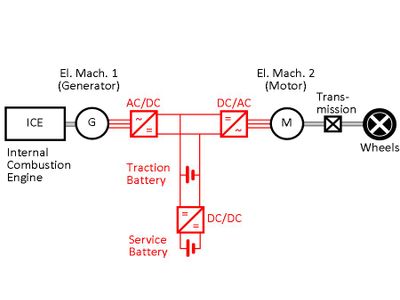EJ2410 Hybrid Vehicle Drives 7.5 credits

There is an increasing demand today to produce more environment friendly vehicles. The combustion engines of today can be improved but in the long run there has to be a change of technology. It will start with electric hybrid vehicles and a possible continuation is with vehicles driven by fuel cells. In parallel to this development the vehicles will contain more and more electrically supplied auxiliary systems.
The course covers both system and component aspects of the propulsion system, as well as the auxiliary systems. Emphasis is put on vehicles based on hybrid and/or fuel cells solutions.
Choose semester and course offering
Choose semester and course offering to see current information and more about the course, such as course syllabus, study period, and application information.
Application
For course offering
Autumn 2024 Start 28 Oct 2024 programme students
Application code
51877
Content and learning outcomes
Course contents
Vehicles of today – propulsion and auxiliary systems.
Driving factors for environment friendly vehicles.
Propulsion and auxiliary systems for hybrid vehicles.
Generic components.
System concepts and simulations.
Development trends.
Intended learning outcomes
Aim of the course is to give a broad insight into alternative solutions for conversion of primary energy to transport activity for road vehicles. Different types of fuel (fossile, bio, …), different types of conversion methods (FC, ICE, HEV), different topologies and auxiliary power systems are considered.
After completed course the student should be able to
- explain how a hybrid vehicle works and describe its main components and their function.
- describe the different hybrid topologies with respect to their functional blocks and their characteristics.
- design and implement both simple and advanced models of the vehicles.
- analyze the performance of a hybrid vehicle.
- build efficiency models of important components.
- evaluate the environmental impact of road vehicles.
- calculate basic electrical and thermal properties for power electronic converters.
- describe the operating principle and properties for the most common types of electrical motors in hybrid technology.
- describe the operating principle for fuel cells and energy storage elements and calculate basic performance of them.
- describe the fuel alternatives for hybrid vehicles.
- solve, in a group, a given assignment and both in written form and orally present and discuss the result.
- discuss about future trends.
Literature and preparations
Specific prerequisites
Completed Bachelor's degree (180 higher education credits), or equivalent academic qualifications. Documented proficiency in English corresponding to English B.
Recommended prerequisites
Basic course on electrical engineering.
Equipment
Literature
Kompendium i Hybrida fordonsdrivsystem, 2006. Kurspärm med projektbeskrivningar och laboration.
Examination and completion
If the course is discontinued, students may request to be examined during the following two academic years.
Grading scale
Examination
- PRO1 - Project, 3.0 credits, grading scale: P, F
- TEN1 - Examination, 4.5 credits, grading scale: A, B, C, D, E, FX, F
Based on recommendation from KTH’s coordinator for disabilities, the examiner will decide how to adapt an examination for students with documented disability.
The examiner may apply another examination format when re-examining individual students.
Other requirements for final grade
One written examination. (TEN1; 4,5 credits)
Two assignments and one laboratory exercise. (PRO1; 3 credits).
Opportunity to complete the requirements via supplementary examination
Opportunity to raise an approved grade via renewed examination
Examiner
Ethical approach
- All members of a group are responsible for the group's work.
- In any assessment, every student shall honestly disclose any help received and sources used.
- In an oral assessment, every student shall be able to present and answer questions about the entire assignment and solution.
Further information
Course room in Canvas
Offered by
Main field of study
Education cycle
Add-on studies
Contact
Supplementary information
N.B. Courses EJ2410 Hybrid Vehicle Drives and EJ2440 Electric Transportation, contain to a certain extent the same material. It is therefore not possible to include both courses for the same degree. A complementary course to EJ2410 Hybrid Vehicle Drives can be EJ2400 Electric Traction.
In this course, the EECS code of honor applies, see:
http://www.kth.se/en/eecs/utbildning/hederskodex.